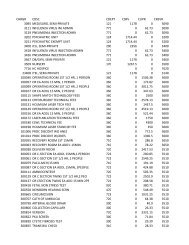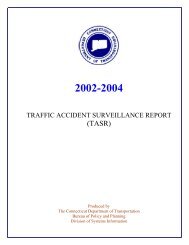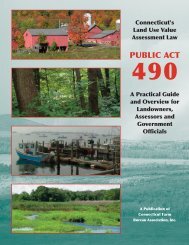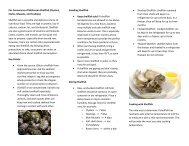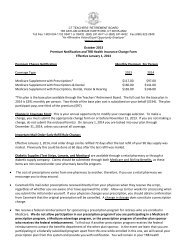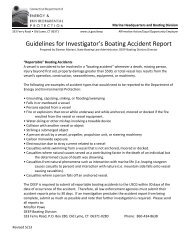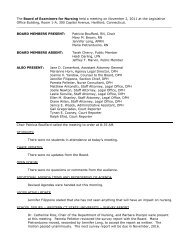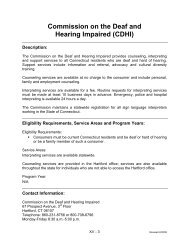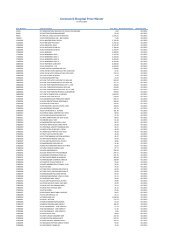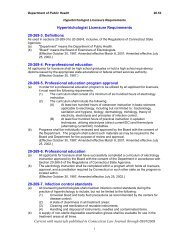2013 CT Anglers Guide - CT.gov
2013 CT Anglers Guide - CT.gov
2013 CT Anglers Guide - CT.gov
Create successful ePaper yourself
Turn your PDF publications into a flip-book with our unique Google optimized e-Paper software.
Header Aquatic<br />
Invasive<br />
Species<br />
Help stop the spread!<br />
A number of aquatic invasive species are established in Connecticut and more are threatening<br />
to invade. This year’s Angler’s <strong>Guide</strong> focuses on the zebra mussel, as it has notably expanded its<br />
distribution in Connecticut during the last several years.<br />
≥≥ZEBRA MUSSEL<br />
Zebra mussels are now found in a number<br />
of locations scattered throughout the<br />
Housatonic River and its impoundments.<br />
Until late 2010 when adult zebra mussels<br />
(Dreissena polymorpha) were found in Lake<br />
Zoar and Lake Lillinonah, zebra mussels had<br />
been found (1998) in <strong>CT</strong> only in East Twin<br />
Lake and West Twin Lake (Salisbury). Since<br />
2010, adult mussels have also been found in<br />
Lake Housatonic and free-floating juveniles<br />
(veligers) have been sampled at several sites<br />
in the river in Connecticut from the Massachusetts<br />
line downstream to Lake Lillinonah.<br />
Surveys completed in late 2012 confirm the<br />
continuing presence of zebra mussels adults<br />
and free-floating juveniles (veligers) in the<br />
Housatonic River and its major impoundments<br />
in Connecticut.<br />
One possible source of these mussels is<br />
downstream migration from Laurel Lake in Lee/<br />
Lenox, Massachusetts. Its short outlet stream<br />
drains directly into the Housatonic River. In<br />
2009, an abundant population of zebra mussels<br />
was documented in Laurel Lake. Adult mussels<br />
were also found that year in the Housatonic<br />
River in Massachusetts downstream of the<br />
confluence with Laurel Lake’s outlet stream.<br />
Since then additional small populations have<br />
been found at sites in the river in Massachusetts.<br />
The non-native zebra mussel was first found<br />
in North America in Lake St. Clair (Michigan/<br />
Ontario) in 1988. Since then they have spread<br />
throughout the Great Lakes, the Mississippi<br />
River system and most of New York State<br />
including Lake Champlain and the Hudson<br />
River, and then into a number of western and<br />
southwestern states.<br />
Zebra mussels have fairly specific water<br />
chemistry requirements and are limited to<br />
waters with moderate to high calcium concentrations<br />
and pH. In Connecticut, suitable habitat<br />
for zebra mussels is mostly limited to a number<br />
of water bodies in western portions of the state.<br />
Under highly favorable conditions, this invasive<br />
mussel can disrupt aquatic ecosystems and is<br />
notorious for clogging water intakes and fouling<br />
boat hulls and engine cooling water systems.<br />
Zebra mussels and other aquatic invasive<br />
species can be inadvertently spread by boats, gear<br />
and bait buckets. Easy “Clean, Drain & Dry”<br />
methods to help prevent their spread can be<br />
found on the next page.<br />
Zebra Mussels in Connecticut<br />
Their current known distribution and the susceptibility of additional Connecticut water bodies<br />
to colonization by zebra mussels.<br />
In 2011 and 2012, Biodrawversity LLC. conducted zebra mussel surveys in northwest Connecticut,<br />
including the upper Housatonic River, to determine the presence or absence of zebra<br />
mussels. Selected physical, chemical, and biological attributes of the surveyed water bodies<br />
were also documented and combined with existing data to develop a risk assessment for those<br />
water bodies. Additionally, a risk assessment was developed that included other water bodies<br />
in the state for which relevant water chemistry data were available. Above is a map showing<br />
the susceptibility of these water bodies (plus some close by NY waters) to colonization by zebra<br />
mussels. All areas assessed as being at being at medium to high risk of colonization by zebra<br />
mussels are located in western Connecticut. (Figure adapted from Biodrawversity LLC. report).<br />
The full report prepared for DEEP by Biodraversity LLC. can be found online at www.ct.<strong>gov</strong>/deep/fishing.<br />
20 <strong>2013</strong> Connecticut Angler’s <strong>Guide</strong>




